
The trading card game space seems to be a bit crowded these days. From your big hitters like Pokemon and Magic the Gathering, to newcomers in the last year like Lorcana and Star Wars Unlimited, to others like Flesh and Blood and Yu-Gi-oh, it seems like there are enough trading card games to go around. When it was announced that another game would be coming from one of Asmodee’s subsidiary companies, when they already released SW Unlimited, I was a little skeptical. Altered, published under French company Equinox, attempts to reinvent the TCG with its “first-of-its-kind” ‘phygital’ integration and unique play style that emphasizes both strategy, exploration and discovery.”
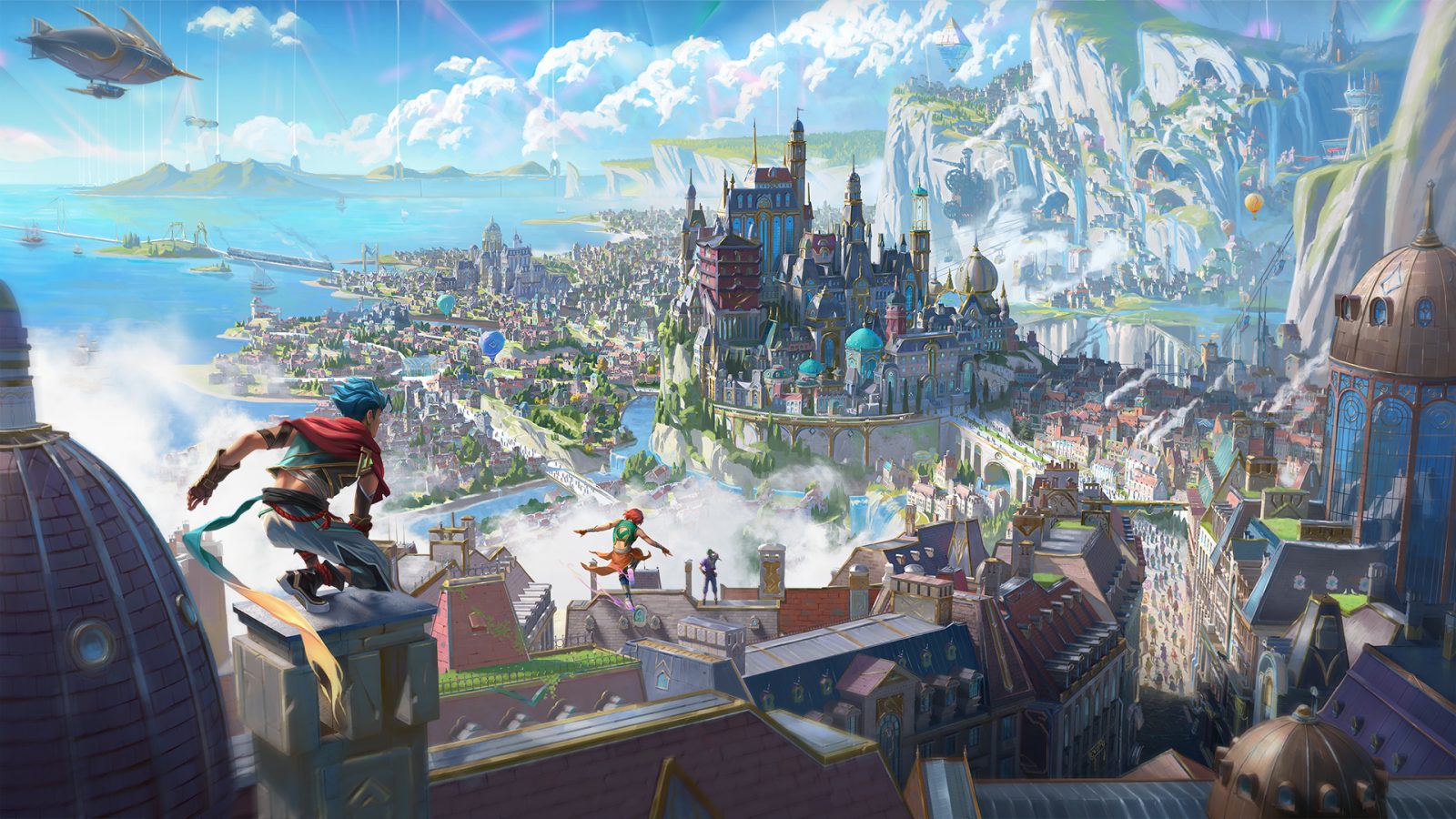
Equinox’s core values for Altered are optimism, community, and kindness. The initial set launched with 18 heroes spread across six factions with new sets expected to be released on a tri-annual basis. Each faction has a 40-card starter deck and 13-card booster packs can be purchased separately. A standard game is played head to head with two players, but multiplayer rules and rules for Booster Drafts and Sealed formats are also available. Equinox launched an initial Kickstarter campaign that raised $6.7 million dollars that featured the starter decks, booster boxes, upgraded player mats and tokens, and faction specific art sleeves for purchase. Altered launched globally on September 13th, 20204.
Flow of the Game

The goal of a game of Altered is to be the first to get your Hero and Companion token to meet across a central tableau of cards. Players will use characters to explore a world where the fictional and real worlds have melded into one. We were able to get a preview of gameplay at GenCon 2024 which you can check out in the attached video.
To play, all Altered Standard decks must contain a minimum of 39 cards plus one hero card. There cannot be more than three copies of a card in a deck. While there are no minimums to the number of Rare or Unique cards that can be in a deck, the maximum allowed is 15 Rares and three Uniques. There are three types of cards in a player’s deck
Heroes – each deck has a hero that provides a special ability for the player to use throughout the game. This card also determines the hero’s faction and the color used for the rest of the cards in the deck.
Landmarks – when played, these cards are permanent and offer ongoing or one time effects each round.
Characters – these cards can be played in support of either their hero or companion and will be used to pass exploration tests toward the end of each round.
Spells – these cards have a one time effect and then move to a player’s reserve.If played from the reserve, the card is discarded.
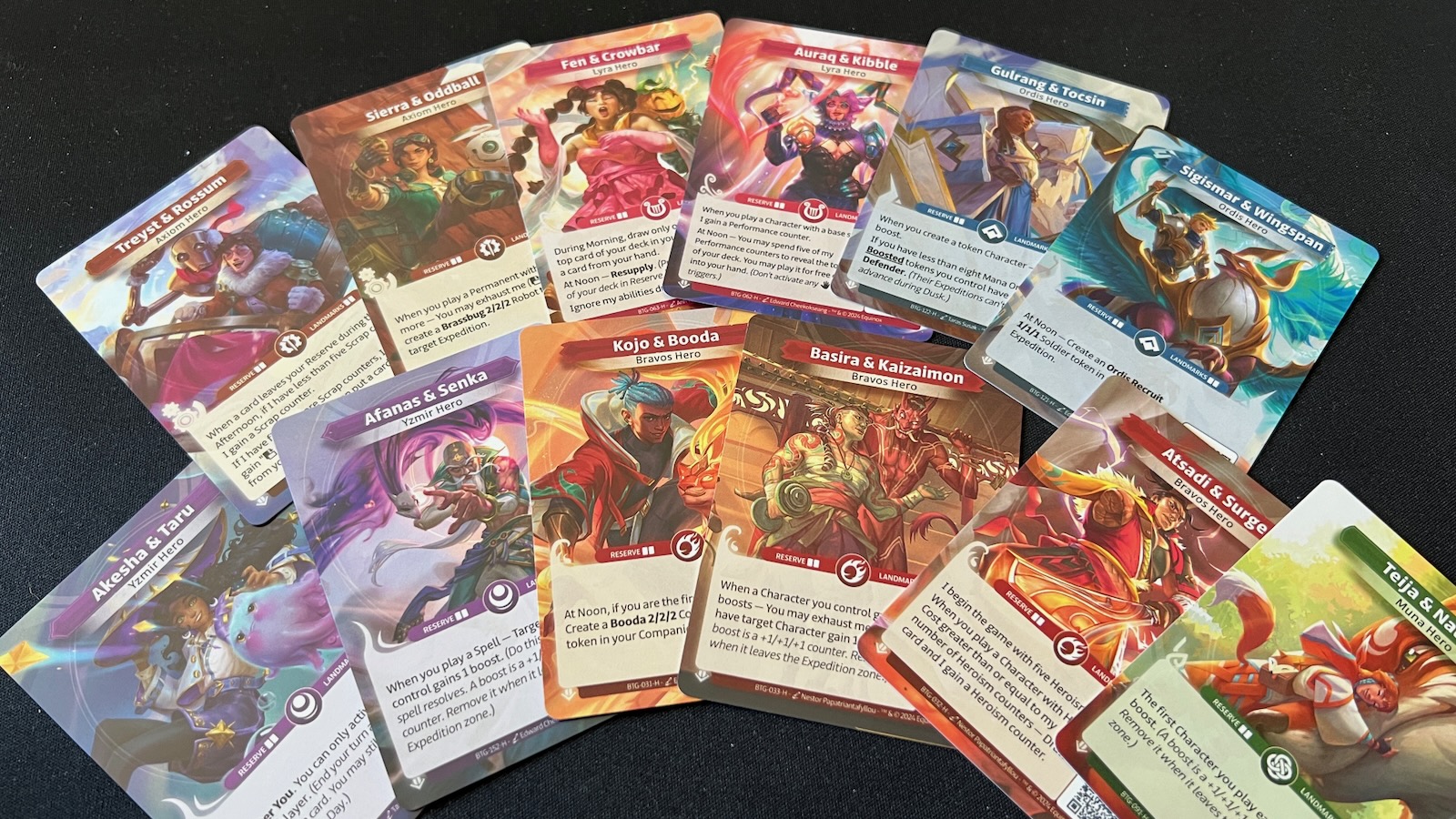
In Altered, all cards in a deck must match a single faction. The game features six different factions each with a different playstyle.
- Axiom (brown) uses technology to their advantage benefitting from interplay between their reserve cards and their landmarks.
- Bravos (red) are all-out brawlers who need to to use their mana well, with overpowered characters and characters who boost their stats when played from reserves.
- Lyra (pink) are the artists of the world with special luck based characters, characters specializing in different regions, and spells to distract their opponents.
- Muna (green) are the naturalists that keep characters in play to create synergies and use powerful cards that also benefit their opponent.
- Ordis (blue) are the faction of order trying to increase their followers to overwhelm their opponents and use their bureaucrats to hinder their opponents progress.
- Yzmir (purple) uses the spiritual realm for late game powerful moves. They will use a variety of spells to control the characters of their opponents.
Players begin the game by placing a Hero region and Companion Region card on either side of the center of the table with their respective hero and companion tokens. Between these cards, players will shuffle and place face down, three tumult cards. Each of these tumult cards will show different regions or combinations of regions that will affect tests throughout the game.

To start the game, each player will draw three cards from the deck, keeping three and placing three cards face down as mana. Players will exhaust mana cards to play cards from their hand or reserves throughout the game. A round in Altered is called a day and each round has a series of phases.
Phase 1 – Morning
Players will change the first player marker, ready any mana or exhausted cards, draw two new cards, and can add a card from their hand to their mana supply.
Phase 2 – Noon
Certain cards in play will have a trigger “At Noon” that will take effect during this phase.
Phase 3 – Afternoon
This is the longest phase of the round with players playing cards from their hands and using printed abilities from cards in play. These abilities may cause a card to be exhausted or discarded after use. Cards can be played from a hand or from a player’s reserve. Players will exhaust mana cards corresponding to the costs printed on each card, with cards usually costing more when played from reserves. Cards played from the reserve gain the fleeting trait which are resolved in Phase 5: Night.
Phase 4 – Dusk
- During this phase, players will compare the statistics on their character cards in each of the hero and companion regions.
- First, players will check the region type of their marker (Forest, Mountain, and/or Water)
- Then players will check the statistics on their character cards in that expedition region.
- If a player’s totals are higher than the other players in any of the regions types, they will move their marker forward one space.
- If a marker moves onto an unflipped tumult card, they will reveal the new card and their regions.
Phase 5 – Night
All cards from the expeditions will move to the reserve. If the card has the fleeting trait, they will be discarded instead. If the reserve has more than three cards, players will have to discard cards until only three are left.
Play will continue until one player’s hero and companion markers meet on the tumult cards.
Production
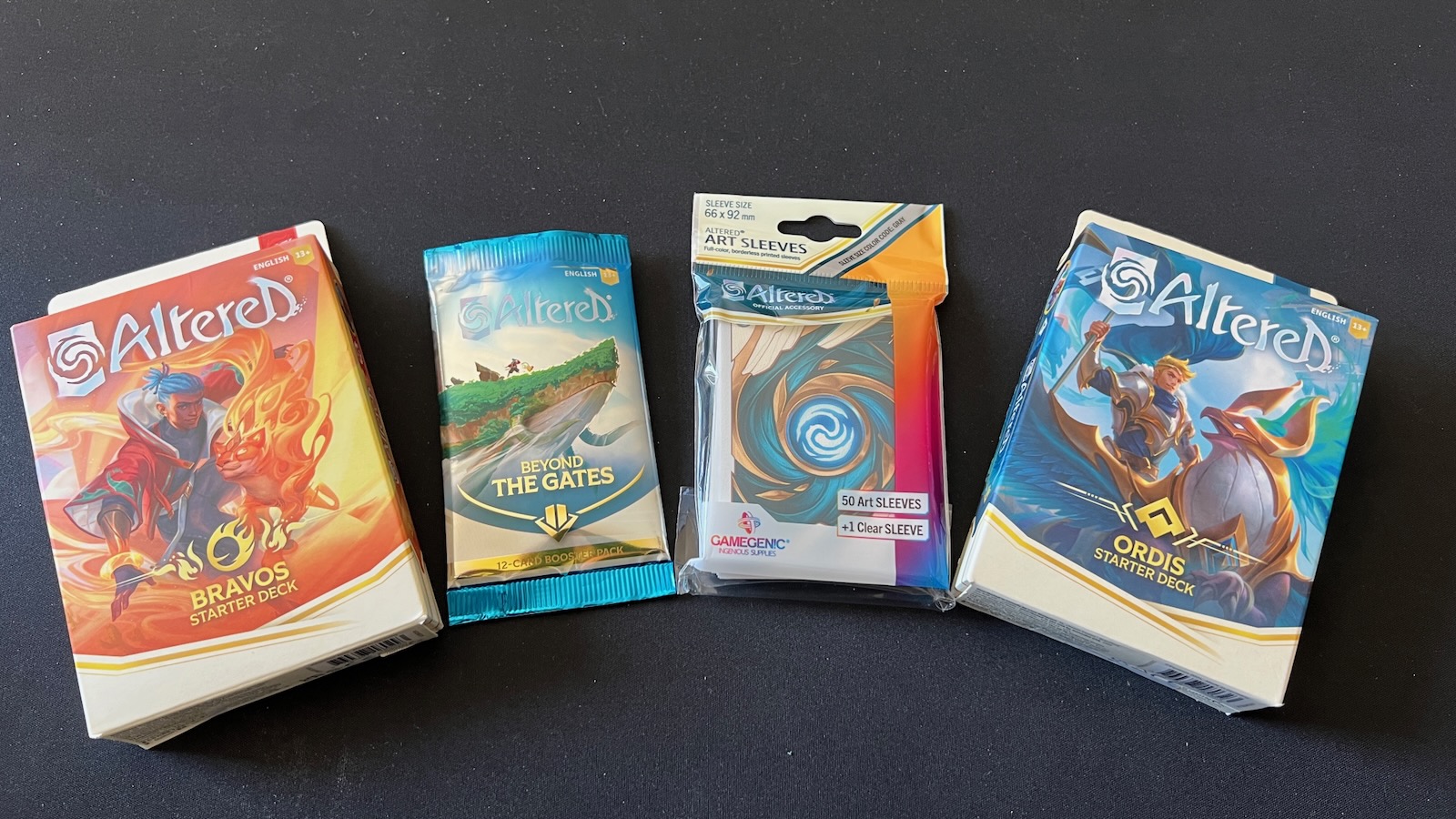
The production of the cards is fairly straightforward and standard for cards in this type of system. Without sleeves, the cards will get worn pretty quickly with the amount of shuffling. We were provided two packs of Gamegenic Sleeves for the two starter decks. The Gamegenic sleeves featured the Altered logo art on the back and came with more than enough sleeves for a standard deck plus one clear sleeve for the Hero card. The sleeves are high quality, shuffled easily, and felt nice in the hand when playing the game. A variety of art sleeves featuring some of the heroes from the game are available for purchase as well.
Each of the starter sets came with a folded paper ruleset describing the basics of the game, card anatomy, and additional rules. The ruleset was easy to follow and helped us get the game to the table fairly quickly. The starter deck also came with a folded player mat featuring artwork from the world of Altered on the back. While this mat was helpful in the fact that it showed you where to put cards you used in the game, the mat never really laid flat and was ditched almost immediately by me and my wife. The tokens included in the packs were very flimsy and difficult to get off the table when they needed to be used. As with most Gamegenic supported games, upgraded tokens, card boxes, and player mats are available to upgrade the game experience.

Aside from the two starter decks, we were also provided with twelve booster packs. The cards were fairly evenly distributed across the six factions. The packs featured three different foil upgrades (1 common, 1 rare, 1 unique), a handful of rare cards spread across the factions, and one unique card.
The artwork featured throughout the game is gorgeous. The game developer was behind other beautiful illustrated games such as Dixit, Dice Throne, and Mysterium – this game features some equally beautiful imagery. Since the world of Altered takes place in a realm where the real world and our fiction/fantasy worlds combine, it is fun to see some of the characters from our childhood stories and history lessons popping off the page. Seeing Amelia Earhardt fighting alongside the 3 Little Pigs against the Frog Prince and Dorthy Gale from the Wizard of Oz is a fun thing to behold.
Online System
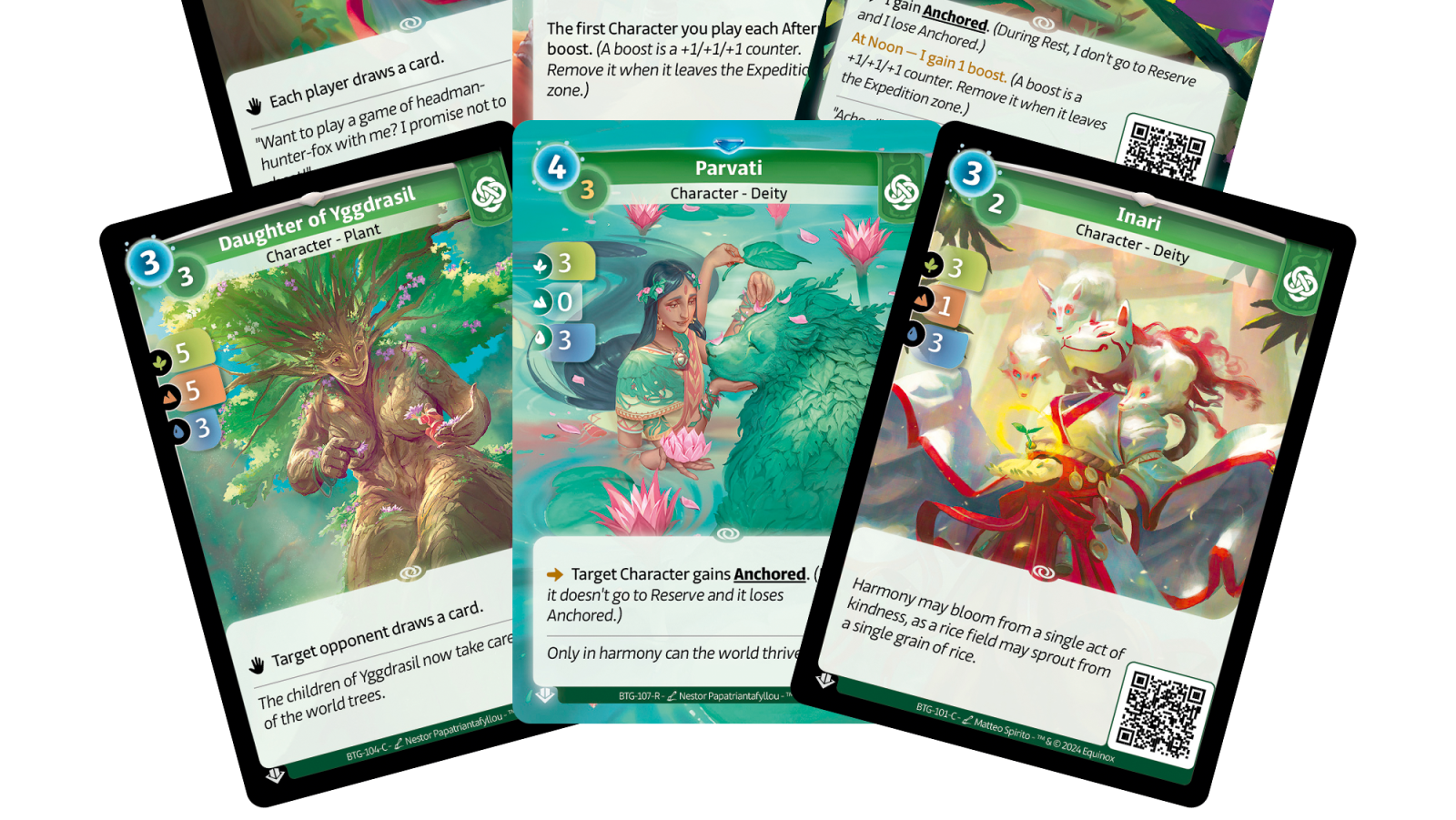
One of the unique features of Altered, is that each card comes with its own unique qr code. When scanned into the companion application or website, it gives you digital ownership of your physical cards. Since each qr code is unique, even if you have multiple copies of the same card, each copy is unique in the world of Altered. Players will have the ability to print on demand a brand new physical copy of newly acquired cards. When scanning the collection into the app, it would sometimes balk at scanning multiple cards of the same type in a single scan run, but would also recognize if you tried to scan a single physical copy of a card multiple times as having its ownership already claimed. This would prevent a physical copy being taken and scanned into someone else’s collection.
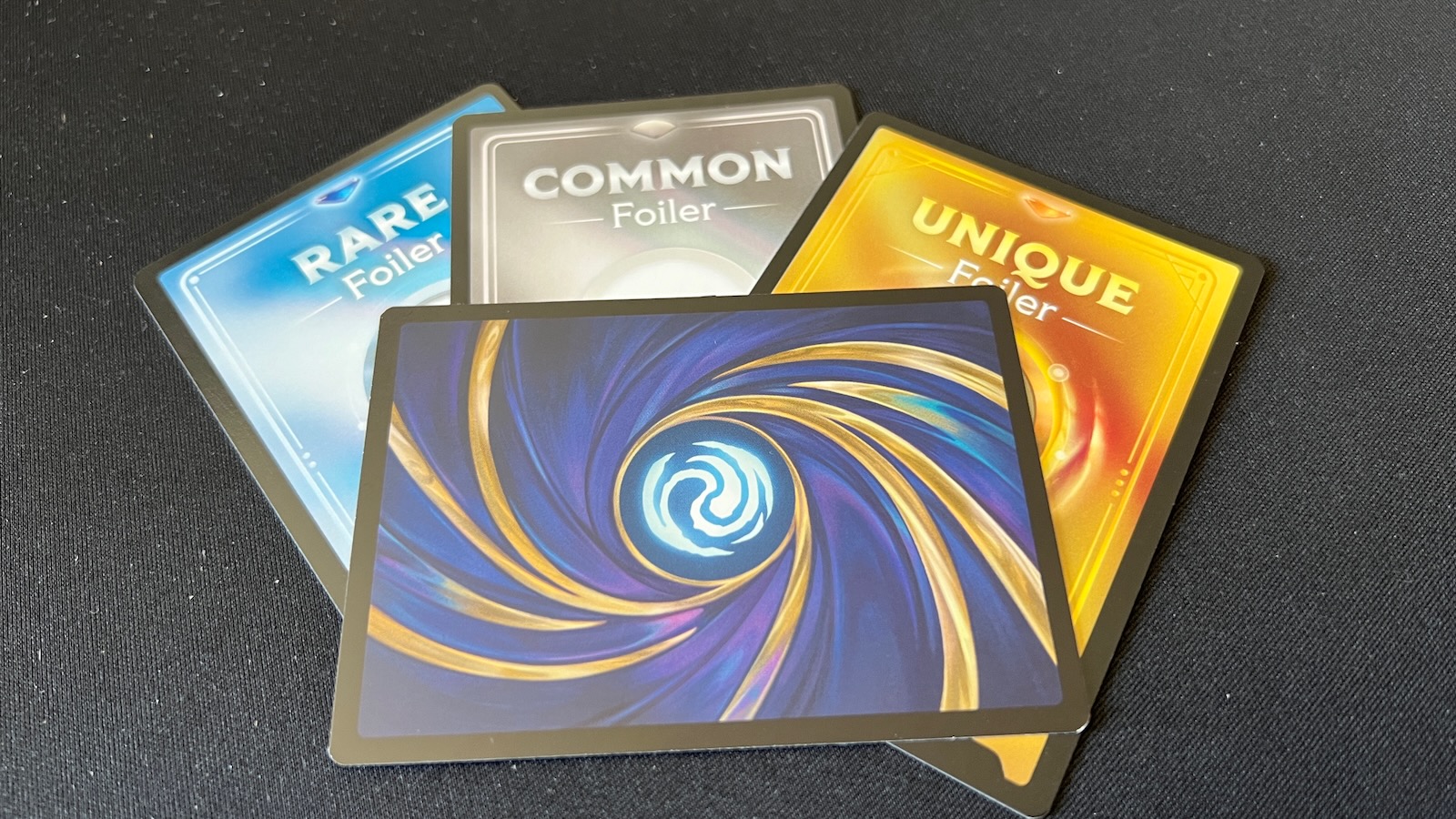
Another unique feature is how cards are foiled. Rather than printing cards with holograms or shiny paper, booster packs come with cards featuring foil upgrades. By scanning a common, rare, or unique foiler card, you can turn your cards into foils digitally, and therefore making them more valuable. Since each physical card in the game is unique, you can choose which of your physical cards you apply a foil to creating your own unique collection. It feels very much like creating your own Non Fungible Token collection of Altered Cards.
Because of this personalized digital collection, much of the marketplace for cards will take place through the application where ownership of cards can be transferred to another player digitally. My biggest question with the online ownership of the cards is the rarity factor. For many, the trading card game is a collectors item. It will be interesting to see how many cards are printed of each rarity and whether or not the market fluctuates for certain cards based on what cards users decide to foil.
Gameplay
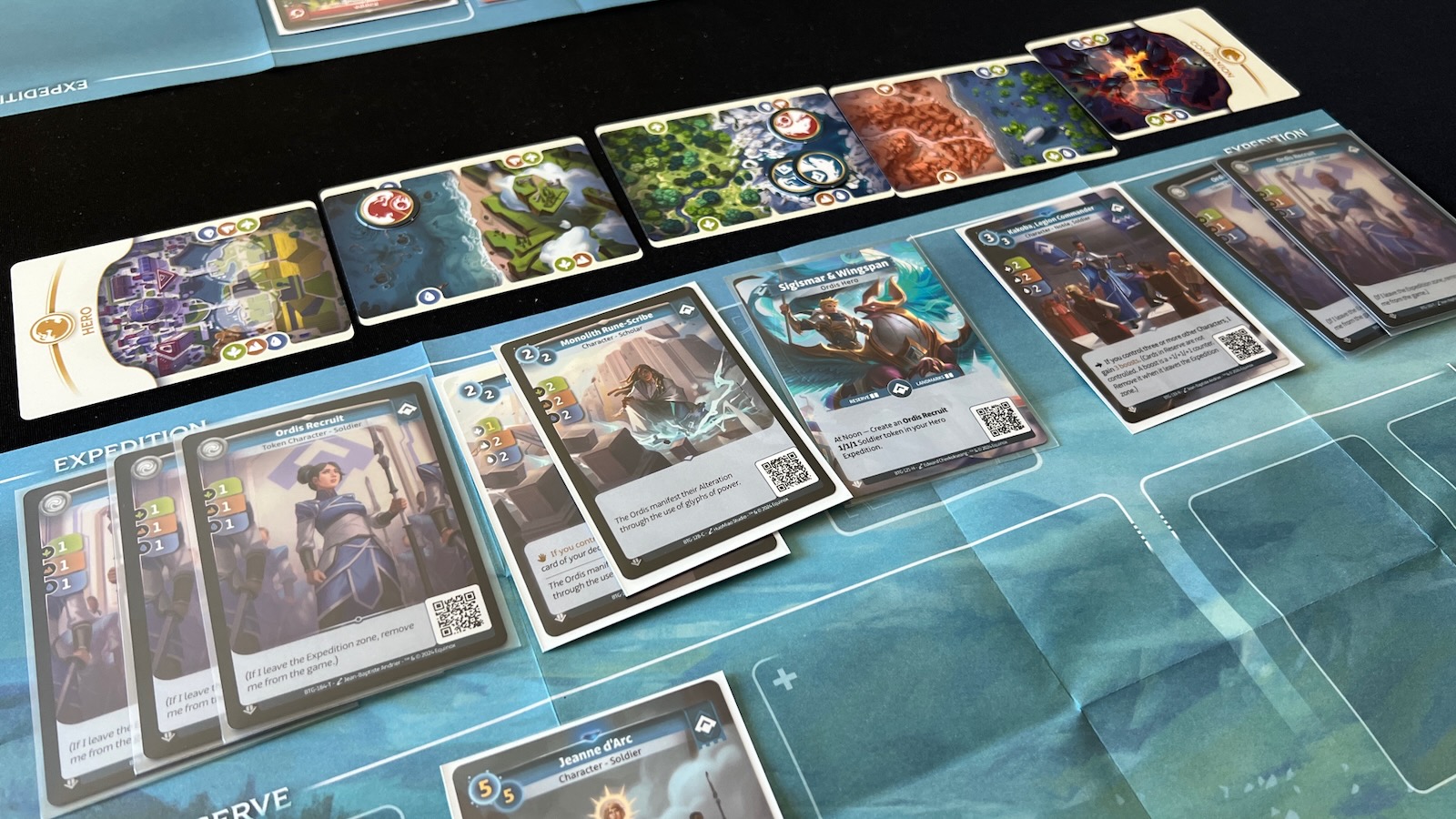
The gameplay is pretty straightforward and accessible to a wide range of ages and experiences. It was fairly easy to teach students of middle school age and didn’t feel overly vindictive as some other TCGs can be. Rather than defeating your opponent, you are just trying to out skill them to move your adventurers faster along a path. Depending on the cards you play on a specific skill test, you may both be able to move forward at the same time if different aspects are larger than the other players. The spirit of the game felt much lighter than other TCGs because you are trying to outmaneuver, rather than destroying the other player. The two factions that I was able to play, Bravos and Ordis, had two very different approaches. With Ordis, I was able to get a slew of token characters on the board with some well timed spells to take out any competition in the regions that were contested. With Bravos, getting some great reserves built up and stockpiling mana allowed me to get some big punches at the right time. I would be interested in playing some of the other factions to see how each of them plays.
Overall Thoughts
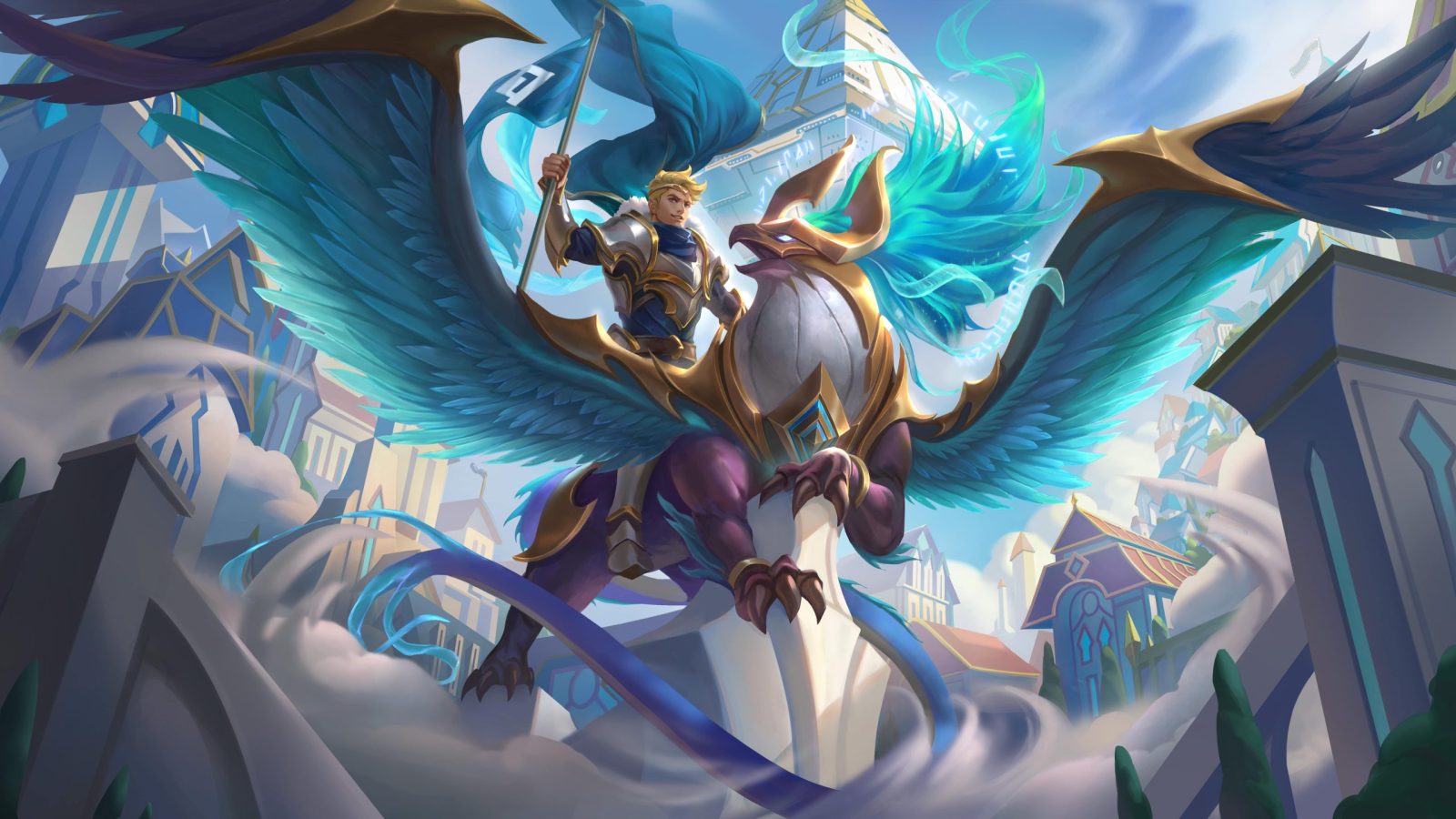
I had a pleasant time playing this game with my wife and teaching it to some of my students. The whole feel of the game is inviting, easy to teach, and doesn’t feel like a battle so much as a contest of wills. Do I think many people who are already deep into other TCGs are going to jump ship and dive into this game? Not really. While there is a lot to like here, I don’t think the game is going to be able to compete with the powerhouses that are already in the space. What I think this game is perfect for are those looking for something a little less daunting than trying to pave a path into the already established game markets. This game is for the younger player looking for their first foray into trading card games or someone looking for a little less of a competitive brain
I love the production and artwork on the cards, but the player bits and mats that come in the starter decks are not great. It’s a shame to have to shell out even more money to get the bits needed to have a great game experience. Kickstarter backers were able to have their pick of art sleeves and upgraded bits, but in the world of TCGs, I’d rather spend money on boosters than playable bits.
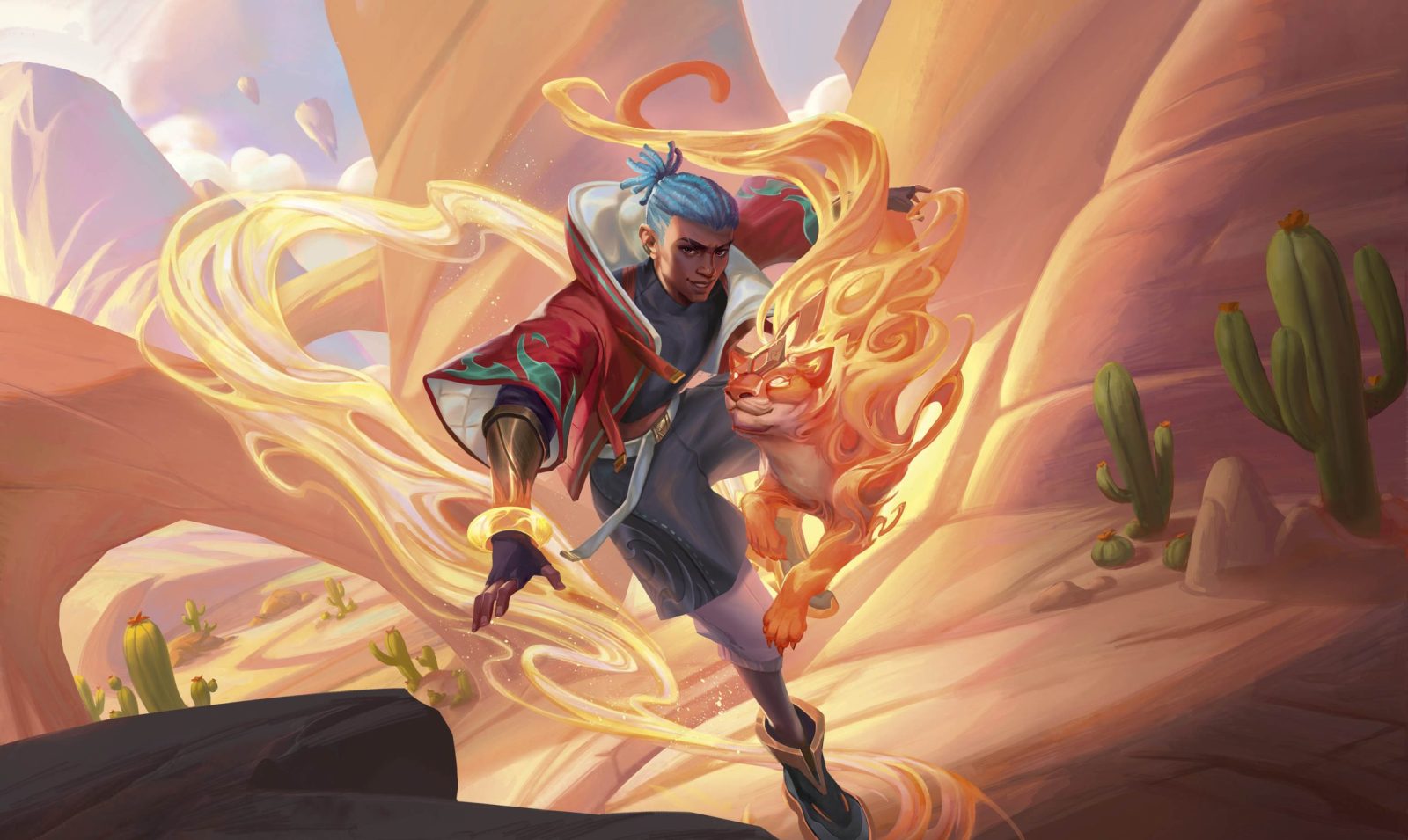
When it comes to deckbuilding, you really need the starter decks to build upon. Since every faction has to be color specific, trying to get all the cards you need through boosters just isn’t feasible. The starter decks give players a great base to start with and as you are buying boosters, you can supplement the decks. In the twelve booster packs I opened, I gained 27 blue cards, 22 red cards, and only a handful of new cards I could use to supplement my decks. I have a real question of how many booster packs I would need to get close to getting the 162 commons and the 324 rare variations in this starter set, if I was a collector. I will say that the deck building restrictions of 15 rares, 3 uniques, and 3 copies of the same card no matter the rarity is a great strategy to balance the decks. With the goal of the game being accessible, the rarity of a card may give a card some extra bonuses, but doesn’t overpower the common version. For example, a common Ordis Trooper gives one skill to each region, but a rare Oridis Trooper gains an additional skill stat in mountains and water.
Altered TCG
Great
Altered should have a place in the TCG world and I hope that it can find some staying power. I don’t think it will take off as quickly as some of its competitors, but if enough people can experience the game, I think it could have some staying power. Easy to learn, easy to teach, fun to play, and a welcoming theme and production value all lend themselves in Altered’s favor. It will be interesting to see how the digital ownership and market take off and what will come with future releases, but I’ll be sticking around to find out.
Pros
- An approachable and easy to play TCG for all ages
- Unique digital ownership of cards
- Beautiful artwork and theming throughout the game
Cons
- Need all six starter decks and some boosters to start the collection
- Need the upgraded Gamegenic bits to enjoy the gameplay
- Entering into a crowded field with some stiff competition
